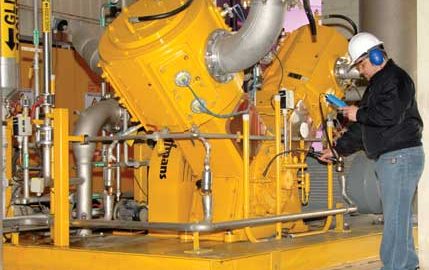
Carlos Valdez uses ultrasound equipment to check the health of an asset
One way that the Tecate maintenance department has gained ground in recent years, and will continue to do so in 2008 and beyond, is through predictive maintenance. Sanchez puts PdM utilization inside MAD because these tools dovetail nicely with each pillar. Used properly, PdM is a key component of planned, scheduled maintenance; can be used to improve the health of equipment and processes; should be part of the M&R strategy for every new piece of equipment; can be on the training curriculum; and works to provide volume to issues found by operators during autonomous maintenance tasks.
The brewery’s PdM program currently includes vibration analysis, infrared thermography, oil analysis and ultrasound.
“Predictive maintenance is an investment in reliability,” says Diaz, who oversees the program along with Carlos Valdez.
Vibration analysis is used extensively on the plant’s 1,137 electric motors. Diaz and Valdez employ DLI Engineering’s Watchman DCX data collector and ExpertALERT software to monitor the condition of big, critical motors (100 to 1,000 horsepower). They use a Vibrotip data collector from Pruftechnik AG for smaller, less-critical motors.
Infrared thermography is used on regular routes to check the site’s electric boards and stations. The ThermoView Ti30 thermal imager from Raytek is the tool of choice. A total of 222 hot spots have been detected in the past three years.
Oil analysis is accomplished with an internal/external strategy. Diaz and Valdez use the OilCheck TMEH 1 handheld instrument from SKF to verify oil condition and perform quick checks for mechanical wear and loss of lubricating properties. More extensive studies and analysis of samples from critical equipment are performed off-site by Mobil and Lubrication Engineers. Work in this area has helped the plant greatly reduce its lubrication consumption. Oil is changed as needed rather than on a calendar basis.
Ultrasonic analysis is used to pinpoint leaks in compressed air, carbon dioxide and steam pipes, as well as to detect electrical arcing conditions and vibration in electric motor bearings. Measurements are taken with the 170M Digital Detector system from SDT North America. These steps have been instrumental in cutting energy usage and costs.
“We are increasing the health and life of our equipment through these tools,” says Diaz. “This is a growing area for us. The more that we use PdM, the more that we decrease corrective maintenance and preventive maintenance.”
Eliminate PMs?
“We are adding reliability by eliminating preventive maintenance,” explains Sanchez. “We have saved 2,600 man-hours by doing this; 2,600 hours that had been set aside for PMs are no longer necessary. Instead, we are using a much smaller amount of time through PdM. The saved time can be used for other activities.”
Sanchez says the department has eliminated 90 percent of preventive work orders for bearings and 100 percent of the orders for electric motors.
“We’ve increased bearing life, saved money and hours, and reduced work orders and paperwork,” he says.
CCM TECATE MAKES THE MOST OF A YOUNG WORKFORCE
MAKING A DIFFERENCE
“The top managers are convinced that MAD is a powerful philosophy that gets results,” says Sanchez. “It’s more than just a great culture. It’s about great results.”
The department hopes to build on those results in the next 12 months by:
1) Expanding the use of Reliability-Centered Maintenance to identify and establish the operational, maintenance and capital improvement policies that will manage the risks of equipment failure most effectively.
“We have dabbled in it previously,” says Sanchez. “We will formally apply it in a pilot area in 2008 and grow it from there.”
2) Addressing opportunities in the maintenance tool cribs.
“We need to improve our levels of spare parts in inventory,” says Espinoza. “We need to adjust minimum/maximum levels and improve our strategic relationships with suppliers. This is all part of our goal to reduce the cost of maintenance.”
3) Expanding PdM to include motor circuit analysis, bearing lubrication monitoring and the general pursuit of best practices in machinery lubrication.
“We are working to analyze and rationalize everything — from our purchasing practices to our PM activities,” says Sanchez. “Everything has to make sense.”
Comprende?
If your TPM efforts or beliefs have gotten lost in translation, you don’t need an interpreter. Success comes by using it as it was originally intended – as a path to better manufacturing, with a constant focus on the creation of value.
EVERYONE SPEAKS THE SAME LANGUAGE
Cervecería Cuauhtemoc Moctezuma believes operators must be trained to not only know how their equipment works, but also to understand the name and function of its various components.
“By doing so, they can convey their needs in the language of the technicians. They can speak the same language,” says Manuel Sanchez, the maintenance manager for CCM’s brewery in Tecate, Mexico. “That improves communication between the two departments. When an operator finds a problem, he or she can now be more specific. Instead of simply telling the technician, ‘My machine isn’t working,’ the operator can now express to the technician that it isn’t working because a specific failure mode is occurring and is localized within a specific component.”
Source: Reliable Plant